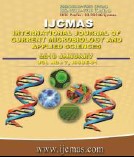


 National Academy of Agricultural Sciences (NAAS)
National Academy of Agricultural Sciences (NAAS)

|
PRINT ISSN : 2319-7692
Online ISSN : 2319-7706 Issues : 12 per year Publisher : Excellent Publishers Email : editorijcmas@gmail.com / submit@ijcmas.com Editor-in-chief: Dr.M.Prakash Index Copernicus ICV 2018: 95.39 NAAS RATING 2020: 5.38 |
A field experiment was conducted during the winter season of 2013-14 at the Crop Research Farm, Department of Agronomy, Allahabad School of Agriculture, SHUATS, Allahabad (U.P.) to study the “Effect of sowing methods and levels of sulphur and boron on yield and economics of mustard (Brassica compestris L.) cv. Peela Sona.”. The experiment was laid out in RBD with twelve treatments and replicated thrice. The plot consisted of three levels of sulphur (15, 30 and 45 kg ha-1), two levels of boron (1 and 2 kg ha-1) with two sowing methods (line sowing and broadcasting) along with NPK each at 80:40:40 kg ha-1 respectively, the results revealed that the maximum no. of siliquae plant-1 (144.86), no. of seeds siliqua-1 (41.60), test weight (3.18 g), seed yield (1.74 t ha-1), harvest index (41.90%) and oil content (44.21%) in the treatment T5 (sulphur 30 kg ha-1 and boron 2 kg ha-1 with line sowing). The maximum total cost of cultivation (34300.68 Rs ha-1) in the treatment T6 and T12 (sulphur 45 kg ha-1 and boron 2 kg ha-1 with line sowing) and (sulphur 45 kg ha-1 and boron 2 kg ha-1 with broadcasting), respectively. The maximum grass return (53860 Rs ha-1) obtained in the treatment T5 (sulphur 30 kg ha-1 and boron 2 kg ha-1 with line sowing). The maximum stover yield (2.70 t ha-1), net return (22899.32 Rs ha-1) and benefit cost ratio (1.82) obtained in the treatment T7 (sulphur 15 kg ha-1 and boron 1 kg ha-1 with broadcasting).
 |
 |
 |
 |
 |